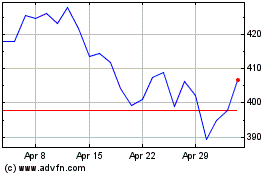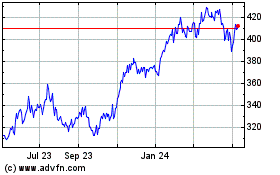By Akane Otani and Michael Wursthorn
The Nasdaq Composite Index overcame an early slump in the second
quarter and is on course to book its eighth straight quarter of
gains, as fears of a trade war stifling global growth pushed
investors to dump industrial stalwarts and increase their bets on
shares of large technology companies.
The tech-heavy index thrived in a tumultuous three months for
U.S. stocks, which struggled to gain ground as investors were
buffeted by worries about trade tensions, political uncertainty in
the eurozone and signs of slowing momentum in the global
economy.
The S&P 500 and the Dow Jones Industrial Average rose 2.9%
and 0.5%, respectively, for the quarter through Thursday, trailing
the Nasdaq's 6.2% advance. The first two remain well below their
January records, while the Nasdaq notched a series of all-time
highs in June.
The one-directional nature of the stock rally has left investors
increasingly worried that a market whose gains have been heavily
dependent on technology stocks could reverse sharply in the second
half of the year.
"A lot of the investing public is piling into the same things,"
said Jim Paulsen, chief market strategist at Leuthold Group, who
added that the S&P 500 would be mostly flat this year without
technology companies. "There's a lot of sheep following one
another."
Investors remained steadfast in holding the shares of
technology-driven companies over much of the second quarter. That
reflects bets firms such as Amazon.com Inc., Netflix Inc., Facebook
Inc. and Twitter Inc. will continue growing, even as many believe
stock gains will slow as monetary policy tightens and the boost
from the tax-overhaul fades. In fact, technology stocks remain
among the best-performing sectors in the S&P 500 even after
recently tumbling on fears that the White House could move to curb
foreign investment in technology firms and sliding at the start of
the quarter on worries the sector could get hit by tighter
regulations.
The five largest publicly traded companies in the world by
market capitalization are now all tech-related, a stark change from
2009, when firms such as General Electric Co. and Exxon Mobil Corp.
dominated the list. Nearly half of global fund managers now say
betting on the FAANG names -- Facebook, Amazon, Apple Inc., Netflix
and Alphabet Inc. -- and their Chinese equivalents ranks as the
most crowded trade in the market, according to a June survey from
Bank of America Merrill Lynch. That marked the highest share of
investors since 2015 to agree that one trade was becoming too
popular.
Tech's growing dominance has skewed the broader S&P 500 away
from so-called defensive stocks -- sectors such as utilities,
consumer staples and health care -- that investors have
traditionally gravitated toward during bouts of market volatility.
That has left some analysts worried investors in index-tracking
funds could be dangerously exposed to a pullback.
The degree of defensiveness within the S&P 500, which
Leuthold Group calculated by using the percentage of the index's
market capitalization comprised of defensive sectors, has fallen
nearly 60% from 1991 through early June, according to the group's
data. That has increased the weighting of highflying growth stocks
within the S&P 500, reducing its overall effectiveness as a
diversified portfolio for investors who opt to passively track the
broad index, Mr. Paulsen said.
The S&P 500 is "not the same index it was when your father
bought it," he added.
Some investors have begun viewing technology stocks as a safety
play, betting that companies that have produced double-digit
percentage gains this year will be able to continue growing
earnings even under more restrictive global trade conditions. While
the broader stock market tends to take a hit following the
announcement of a trade action, technology stocks are among the
best-performing stocks in the 30 days after a trade action is
announced, implemented or ended, according to BofA Merrill Lynch
data going back to 1995.
To many investors, the technology sector's track record of
earnings growth supersedes risks like trade tensions and the
possibility of tighter regulations. Amazon's quarterly profit
topped $1 billion for the first time in the most recent quarter,
while Facebook's earnings soared even after its user-data crisis
and Microsoft posted double-digit growth in profit and revenue.
"Long term, it looks like a legit growth story," said Paul
Christopher, head of global market strategy for Wells Fargo
Investment Institute.
Yet some analysts worry that, with uncertainty swirling over
whether the U.S. will ratchet up trade tensions with China, the
European Union and others, investors have mispriced the risk that
the sector faces.
Technology companies in the S&P 500 have the highest share
of overseas revenue of the broad index's 11 sectors, with a
foreign-exposure level of about 59%, according to FactSet and BofA
Merrill Lynch data. That is greater than the broader S&P 500,
which gets about one-third of its revenue from overseas and
indirect exposure via commodities, the bank added.
That makes the sector particularly vulnerable to restrictions on
trade and investment. The Nasdaq on Monday posted its biggest
one-day decline since April after reports suggested the Trump
administration was planning to curb foreign investment in U.S.
technology firms. The tech sector's high exposure to foreign
revenue also exposes it to swings in the foreign-exchange market:
Should the recent rebound in the U.S. dollar continue, that could
hurt multinationals whose goods will become more expensive to
foreign buyers, and overseas revenue will be worth less when
converted back into dollars.
Even as investors say technology firms as a whole appear to be
on more stable footing than they were at the height of the dot-com
era in 2000, many remain cautious, citing the tendency for the
stock market to contract when it is led by just a handful of
outperformers.
"Whenever the market narrows like this and everyone wants to own
the same stocks like the [FAANG] stocks, there is a feeding frenzy
that can go on for a while," said Mike Balkin, a portfolio manager
at William Blair. "When it ends, it usually doesn't end well."
Write to Akane Otani at akane.otani@wsj.com and Michael
Wursthorn at Michael.Wursthorn@wsj.com
(END) Dow Jones Newswires
June 29, 2018 05:44 ET (09:44 GMT)
Copyright (c) 2018 Dow Jones & Company, Inc.
Microsoft (NASDAQ:MSFT)
Historical Stock Chart
From Mar 2024 to Apr 2024

Microsoft (NASDAQ:MSFT)
Historical Stock Chart
From Apr 2023 to Apr 2024
